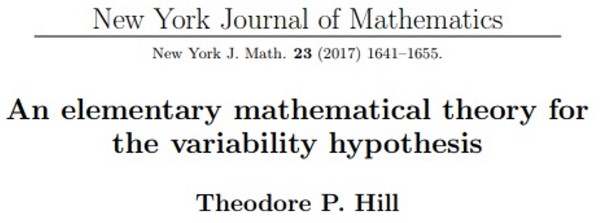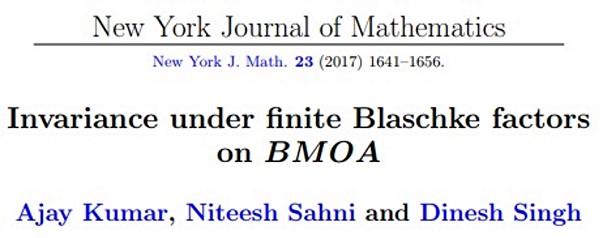Paper is rejected twice: Cure is worse than disease
A professor of mathematics, Theodore P. Hill, devised what is sometimes called a toy model to help explain why males of our species display greater variability than females. He submitted the paper to two journals in succession, and both rejected the paper after having previously accepted it.
As far as I can tell, the premise of the article, that males display greater variance (particularly of intelligence), is generally accepted. Professor Hill developed a toy model, which is to say an oversimplified model designed to shed some light on a complicated problem; the term is not pejorative. According to Prof. Hill’s account, he enlisted the help of another mathematician, Sergei Tabachnikov of Pennsylvania State University, and submitted the paper to the Mathematical Intelligencer. According to Prof. Hill, the manuscript was scheduled to appear in the journal’s first issue of 2018. What happens next, at least in Prof. Hill’s version, is complex, and I do not want to describe it in detail. The Penn State chapter of Women in Mathematics contacted Prof. Tabachnikov and warned him that he might appear to be supporting a set of sexist ideas and that many of their members have “strong disagreements” with the paper. Ultimately, someone contacted the National Science Foundation, which requested that their name be removed from the paper, and the journal rescinded its acceptance for fear that “the right-wing press” would use it to their advantage.
Professor Hill claims that Amie Wilkinson, a mathematics professor at the University of Chicago, and her father, a statistician (who I think is not named), wrote to the editor of the Mathematical Intelligencer and announced that the article oversimplified to the point of embarrassment. The article was pulled. For her part, Prof. Wilkinson, in a Statement addressing unfounded allegations, says that she criticized the paper and recommended that the journal publish a rebuttal. By this time, Prof. Tabachnikov had removed his name from the paper.
Oddly, an editor at the New York Journal of Mathematics contacted Prof. Hill and offered to publish the paper. It appears as though the paper was actually typeset, because you can see a pdf of it here, and the title page looks like this:

Yet if you go to the journal, you will find a substitute paper,

which has almost the same pagination and must have been rushed into print within a few days, if Prof. Hill’s chronology is accurate. Professor Hill blames the retraction on Benson Farb, a member of the editorial board, who is married to Prof. Wilkinson and whose father-in-law is the anonymous statistician. Professor Farb supposedly wrote a somewhat intemperate letter threatening the editor of the journal with its imminent demise, unless the paper was pulled. Professor Farb posted a Statement in response to Ted Hill’s unfounded allegations, in which he says he was indeed concerned about the quality of the paper and also the appropriateness for a theoretical mathematics journal. He notes in his statement that Prof. Wilkinson had no role in the process.
In a couple of comments on Prof. Hill’s blog post, the editor of NYJM, Igor Rivin, expresses his disappointment that this interesting paper was not, in the end, published. Indeed, he calls the process censorship. But he shed no light on who censored the paper and why. In further comments here, Prof. Rivin disputes part of Prof. Farb’s statement concerning the referees’ reports. It seems unlikely that we will ever know exactly what happened.
Whatever the merits of his paper, Prof. Hill is correct that pulling a paper as his paper was pulled is appalling. It is probably unprecedented that the paper was pulled twice while it was on the very brink of publication. Maybe it should never have been accepted for publication, but it was, twice. Professor Wilkinson is correct that, given that it had been accepted, the paper should have been published in the Mathematical Intelligencer. If readers did not like it, they were free to comment. I did not particularly credit Prof. Wilkinson’s suggestion that comments be published in the same issue, simply because time would not have allowed that, and the paper had already been scheduled.
What are the merits of the paper? I am neither a mathematician nor a biologist, and I did not read the paper. I skimmed a blog entry by the eminent mathematician Timothy Gowers of Cambridge University. Professor Gowers criticized the model in his first blog entry, evidently read many of the comments to that entry (as did I), and wrote a second entry that was somewhat more favorable to the original article. I do not want to go beyond that but rather concentrate on the controversy surrounding the rejections of the paper.
Professor Hill provides evidence that the paper was pulled after two Penn State professors, Diane Henderson and Nate Brown, reported to NSF that it “appears to promote pseudoscientific ideas that are detrimental to the advancement of women in science.” Those “pseudoscientific ideas” evidently refer to the assumption that males display greater variance than females (the Greater Male Variability Hypothesis, or GMVH), and not only in mathematics. As far as I know, the hypothesis is well-founded; see, for example, The science of sex differences in science and mathematics. The hypothesis leads to the conclusion that, in the tails of the distribution, there are apt to be more mathematically astute males than females (also more males who cannot add two numbers, but no one seems to object to that conclusion). Thus, the paper was ultimately rejected because it accepted well-founded ideas that some people did not like for what are basically political reasons. See also: climate-change denial.
As for the concern that the “right-wing press” would discover the article and exploit it: the right-wing media would probably never have noticed an obscure article in a comparatively specialized journal. But because the article was – let’s be honest – censored and Prof. Hill went public with his article in Quillette, the right-wing media were all ears; see, for example, Mortarboard mob “disappears” respected mathematician, A mathematics paper two math journals were mau-maued into suppressing, or Math journal kills research study after PC backlash, the last, please note, in Breitbart.
If Prof. Hill’s paper was censored to bury its adherence to the greater male variability hypothesis, then the cure was worse than the disease.
Moral: If someone submits a trivial paper to an unknown journal, you may do more harm than good by trying to suppress it.
You may find 2 versions of Prof. Hill’s paper here and here. Jonathan Kane first alerted me to this controversy. Emily Willoughby provided me with some annotated references on greater male variance. Neither has previewed this article, so any errors in it are mine alone.
